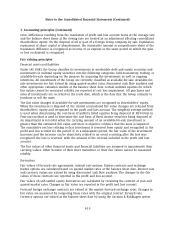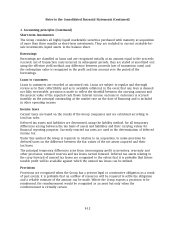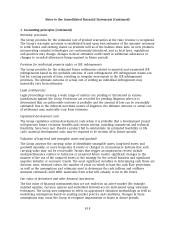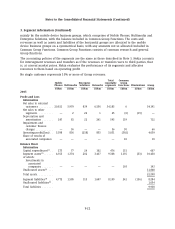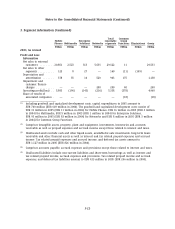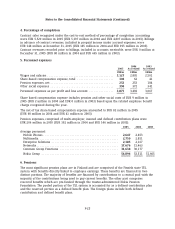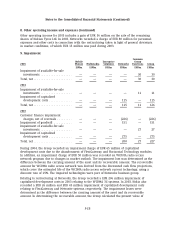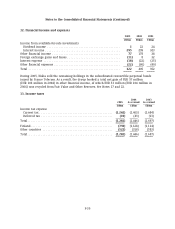Nokia 2005 Annual Report Download - page 158
Download and view the complete annual report
Please find page 158 of the 2005 Nokia annual report below. You can navigate through the pages in the report by either clicking on the pages listed below, or by using the keyword search tool below to find specific information within the annual report.
Notes to the Consolidated Financial Statements (Continued)
2. Adoption of IFRS 2 and IAS 39(R)
The comparative figures for 2004 and 2003 have been revised to reflect the adoption of IFRS 2 and
IAS 39(R) and the effects are summarized as follows:
2004 2003
IFRS 2 IAS 39(R) Total IFRS 2 IAS 39(R) Total
EURm EURm EURm EURm EURm EURm
Increase in net sales ...................... — 104 104 — 78 78
Increase in cost of sales .................... — (46) (46) — (88) (88)
Increase in research and development expenses (43) — (43) (28) — (28)
Increase in selling and marketing expenses .... (12) — (12) (8) — (8)
Increase in administrative and general expenses (7) — (7) (5) — (5)
Increase (-)/decrease (+) in tax expense ....... 2 (13) (11) — 2 2
Increase (+)/decrease (-) in profit attributable to
equity holders of the parent .............. (60) 45 (15) (41) (8) (49)
Decrease in accrued expenses ............... (2) — (2) — — —
Increase in provisions ..................... 9 — 9 — — —
Increase in share issue premium ............ 94 — 94 41 — 41
Decrease in fair value and other reserves ...... — (56) (56) — (12) (12)
2004 2003
IFRS 2 IAS 39(R) Total IFRS 2 IAS 39(R) Total
EUR EUR EUR EUR EUR EUR
Decrease in basic earnings per share .......... (0.01) 0.00 (0.01) (0.01) 0.00 (0.01)
Decrease in diluted earnings per share ........ (0.01) 0.00 (0.01) (0.01) 0.00 (0.01)
3. Segment information
Nokia is organized on a worldwide basis into four primary business segments: Mobile Phones;
Multimedia; Enterprise Solutions; and Networks. Nokia’s reportable segments represent the
strategic business units that offer different products and services for which monthly financial
information is provided to the Board.
Mobile Phones connects people by providing expanding mobile voice and data capabilities across a
wide range of mobile devices.
Multimedia brings connected mobile multimedia experiences to consumers in the form of
advanced mobile devices and applications.
Enterprise Solutions offers businesses and institutions a broad range of products and solutions,
including enterprise-grade mobile devices, underlying security infrastructure, software and
services.
Networks provides network infrastructure, communications and networks service platforms as
well as professional services to operators and service providers.
In addition to the four business groups, the Group’s organization has two horizontal units to
support the mobile device business groups, increase operational efficiency and competitiveness,
and to take advantage of economies of scale: Customer and Market Operations and Technology
Platforms. The horizontal groups are not separate reporting entities, but their costs are carried
F-20


